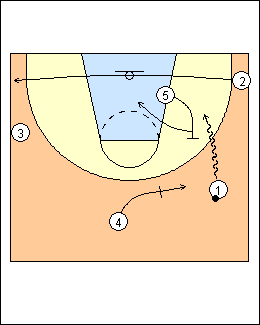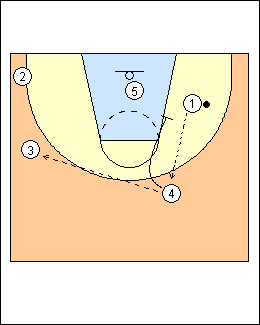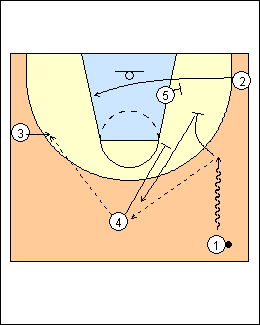Lawrence Frank ballscreens
 | 1 Lawrence Frank 1) Straight on 3) Strong 4) L-action 5) Swing 6) Slice What do you do after the play is over, how do you keep the flow? They teach their guys the play after the play (playoff basketball), introduce the pick and roll game, which is the hardest thing to guard at any level. When he did rehearsal offence in New Jersey, they would often start at the end then work their way back. 1) Straight on The straight-on pick and roll is probably the hardest to guard. Very rarely in the NBA do you see screens bringing a guy from sideline to sideline, most screens come up from the nail. From 3-out 2-in, the screener sprints up through the nail and changes the angle at the last second based on how the defence is playing. The wings flatten out to the corners. There are four S's (reads) for the ballhandler, a) starting point - need to know who you are, if you can't shoot, the defence will go under, move the screen lower, if you are a speed demon, give yourself space to get a head of steam b) set-up - you have to be a threat to beat him away from the screen, e.g., to go right, first knock him off left on the dribble (dribble jab or crossover), or from triple threat, jab or crossover step, give the screener a better angle, and if the defender doesn't react, you're gone c) separation - take at least two dribbles, attack downhill, not east-west d) score - shoot |
 | 2 If 1 throws back to 4 on a pick and pop, 4's looks are shoot, high-low pass to 5 on a duck-in, or weakside for a two-man game, pass and follow to ballscreen (3 makes it a shorter pass on 4's catch). There is a triangle away, low post 5 empties out and goes weak below the block, 1 separates outside the arc. 3 is a threat to beat his man away. Here 4 picks and pops, 5 ducks in from the weakside. If X4 is showing, you have to punish a show, 1 sees the show and comes up higher weakside, 3 makes a kick pass to 1, 4 rolls, pass right to the roll, or 5 ducking in, it's two-on-one, 1 is the trigger man. The objective in pick and roll is four against three. If 3 is not a great ballhandler, 4 will pass to 3, take a step, come to a jump stop, show his outside hand for a return pass, then 3 goes backdoor or comes off for a handoff. (Variation - 4 just dribbles at 3 for a backcut or handoff, without passing) |
 | 3 |
 |
 | 4) L-action 5 sets a step-up screen for 1, 4 gives 1 another option, a high ballscreen, 2 goes through. a) If 1 uses 5, 5 rolls, 4 replaces |
 | 7 On a throwback to 4 he looks for a shot, high-low, or a pass to 3, and can follow to play with 3 or go away to play with 1 (screen away, shown), but is not going to stand. |
 | 8 |
 |
 | 6) Slice If there's too much pick and roll and you want to get some movement. The Celtics run this. After the other team scores, instead of walking the ball up and calling a set, flow into an alignment that gives you 6 or 7 options. 1 brings the ball up, the first look is 5 and 2 is always an option, he passes to 4 if it's not there, 4 swings the ball to 3 (who gets a little closer to the elbow) and screens away at the elbow. 2 can use a single screen by 5 or the stagger screen by 1 and 4, 1 goes opposite 2. Here 2 uses 5's screen then posts, 1 comes off 4. See Fast breaks - Bradley, Spurs 2007. |
 | 11 3 passes to 1 and pins down for 2, who can use the pin-down or a stagger screen by 5 and 4. Here 2 uses the pin-down, so 3 uses the stagger. 4 spaces after screening. (Variations) - 2-5-4 screen for 3, 5 and 4 can then get 2 - 3 stays wide, 2 uses the 5-4 stagger, 1 drives a gap up top. See Offence - Seth Greenberg slice. |
 | 12 Here 2 uses the stagger screen, 3 pops back out. (Variation - 5 and 4 go get 3). See Fast breaks - Triano early offence (reverse, corner).  |
This page was made with Basketball playbook from Jes-Soft
